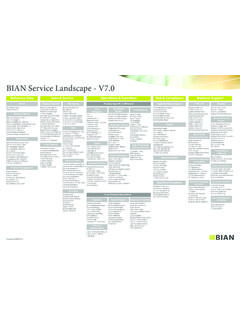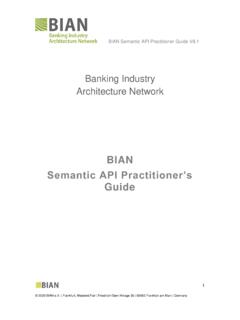Transcription of BIAN
1 Banking Industry Architecture Network bian . How-to Guide Semantic API. 2018 bian | Box 16 02 55 | 60065 Frankfurt am Main | Germany Page 1 of 54. bian How-to Guide Semantic Organization Authors Role Name Company bian Architect Guy Rackham bian . Status Status Date Actor Comment / Reference DRAFT January 2018 Restructure, Figures Approved Architectural Committee Version No Comment / Reference Date First edited version January 2018. 2018 bian | Box 16 02 55 | 60065 Frankfurt am Main | Germany Page 2 of 54. bian How-to Guide Semantic Copyright Copyright 2018 by bian Association. All rights reserved. THIS DOCUMENT IS PROVIDED "AS IS," AND THE ASSOCIATION AND ITS MEMBERS, MAKE. NO REPRESENTATIONS OR WARRANTIES, EXPRESS OR IMPLIED, INCLUDING BUT NOT LIMITED. TO, WARRANTIES OF MERCHANTABILITY, FITNESS FOR A PARTICULAR PURPOSE, NONINFRINGEMENT, OR TITLE; THAT THE CONTENTS OF THIS DOCUMENT ARE SUITABLE FOR. ANY PURPOSE; OR THAT THE IMPLEMENTATION OF SUCH CONTENTS WILL NOT INFRINGE ANY.
2 PATENTS, COPYRIGHTS, TRADEMARKS OR OTHER RIGHTS. NEITHER THE ASSOCIATION NOR ITS MEMBERS WILL BE LIABLE FOR ANY DIRECT, INDIRECT, SPECIAL, INCIDENTAL OR CONSEQUENTIAL DAMAGES ARISING OUT OF OR. RELATING TO ANY USE OR DISTRIBUTION OF THIS DOCUMENT UNLESS SUCH DAMAGES ARE. CAUSED BY WILFUL MISCONDUCT OR GROSS NEGLIGENCE. THE FOREGOING DISCLAIMER AND LIMITATION ON LIABILITY DO NOT APPLY TO, INVALIDATE, OR LIMIT REPRESENTATIONS AND WARRANTIES MADE BY THE MEMBERS TO THE. ASSOCIATION AND OTHER MEMBERS IN CERTAIN WRITTEN POLICIES OF THE ASSOCIATION. 2018 bian | Box 16 02 55 | 60065 Frankfurt am Main | Germany Page 3 of 54. bian How-to Guide Semantic Contents Inhoud 1. Introduction .. 6. 2. bian Design Principles .. 7. - bian Service Domain Architectural Properties .. 8. - Business Role/Scope of Activity of a Service 9. Internal Operation of a Service Domain .. 12. Service Based Access .. 13. Determining Message Content .. 15. 3.
3 Key Benefits of using bian to design API 17. Support for Emerging Industry 17. Support for Industry 19. Support for Incremental Adoption/Migration .. 20. 4. Using bian as an API Inventory'.. 22. 5. Three Levels of architectural alignment .. 24. Direct to Core .. 24. Wrapped Host .. 26. Micro-Service Architecture .. 28. 6. bian Design elements used in API specification.. 31. Extended Service Domain Specifications .. 31. Wireframes (showing enterprise boundaries) .. 32. Business Scenarios .. 34. Service Operations .. 35. 7. bian API Design Approach .. 37. General Implementation Considerations .. 37. Semantic API Selection Framework .. 38. Service Domain Cluster .. 40. For Level 1 Direct to Core .. 42. For Level 2 Wrapped 43. For level 3 Micro-service Architecture .. 44. 8. bian Design Content SL V .. 48. Attachments - Example Wave 1 Deliverables .. 50. The wireframe .. 50. Business Scenarios .. 51. 2018 bian | Box 16 02 55 | 60065 Frankfurt am Main | Germany Page 4 of 54.
4 bian How-to Guide Semantic Figure 1: Simple Schema of a Service Domain Design .. 10. Figure 2: Functional Patterns & Their Generic Artifacts .. 10. Figure 3: Value Chain Layout .. 11. Figure 4: Functional Patterns, Generic Artifacts and Behavior Qualifer Types .. 12. Figure 5: Service Domain Behavior Qualifers Added to Service Operations .. 13. Figure 6: bian Action Terms .. 13. Figure 7: Default Action Term By Functional Pattern .. 14. Figure 8: bian Service Domains Related to Micro- services .. 19. Figure 9: The Service Landscape with Open API Candidates .. 23. Figure 10: Example Wave 1 Service Operation Descriptions .. 23. Figure 11: Summary of API Sophistication Levels .. 24. Figure 12: Level 1 Layout .. 25. Figure 13: Level 2 Layout .. 27. Figure 14: Level 3 Layout .. 28. Figure 15: Expanded Service Domains (Excel) .. 32. Figure 16: Wireframe Example from Wave 1 .. 33. Figure 17: Mobile Access Wireframe with Time Dependencies.
5 34. Figure 18: Example Business Scenario .. 35. Figure 19: Service Operation Definition .. 36. Figure 20: Simplified API Technique Framework .. 38. Figure 21: List of 28 Techniques Under the 4 Categories .. 40. Figure 22: Application Cluster Example .. 42. Figure 23: Level 3 With Contact Points Highlighted .. 45. Figure 24: Level 3 - Expanded Customer Access 46. Figure 25: API Content Development Approach .. 48. Figure 26: Wireframe example - Customer offers / onboarding .. 50. Figure 27: Prospect On-boarding (KYC) .. 51. Figure 28: Suitability/Eligibility 51. Figure 29: Configuration and Pricing 52. Figure 30: Credit/Risk/Underwriting Decisions .. 52. Figure 31: Documentation & Compliance 53. Figure 32: Product Booking, Recording and Set-up Initiation .. 53. 2018 bian | Box 16 02 55 | 60065 Frankfurt am Main | Germany Page 5 of 54. bian How-to Guide Semantic 1. Introduction This is the second version of the bian Semantic Application Programming Interface (API) How to Guide.
6 It is being released in conjunction with the bian Service Landscape Version ( ). The bian release includes significant content extensions that support the use of the bian Service Landscape as an API. solution directory and bian specifications as high-level designs for standards-based API development. The intended audience for the guide is business and technical architects tasked with the development and deployment of API Ecosystems. It assumes a basic understanding of the bian design principles and content. A brief summary of the bian approach is included near the beginning of this guide to provide background. The guide is set out as follows: bian Design Principles an overview of key bian design principles and techniques as they apply to API design Key benefits of using bian the bian design properties that support API design bian Service Landscape API Inventory the bian SL can be used to classify and inventory available open' APIs Three Levels of alignment The full adoption of a componentized model is likely to be a migration for most participants three distinct stages of evolution are defined bian API design elements descriptions and examples of the bian .
7 Design artifacts used in semantic API specification bian API approach some general solution development techniques and then adoption approaches specific to each of the three defined levels of bian alignment An overview of bian API Wave 1 content bian API aligned specifications published with bian The bian model of banking adheres to key principles by defining discrete Service Domains' that perform standard (canonical) business roles. The bian Service Domains interact through service operations and these service operations can be used to outline the business purpose and high-level information content of APIs where appropriate. The interaction of service domains and service operations represent information flowing through an organization. 2018 bian | Box 16 02 55 | 60065 Frankfurt am Main | Germany Page 6 of 54. bian How-to Guide Semantic 2. bian Design Principles The bian design principles are fully described in the bian How To Guides published with each release of the Service Landscape.
8 A summary of the main concepts is provided here with emphasis on how the bian design approach supports API. specification for reference. Different Model Perspective bian defines a particular model of banking activity. As opposed to more traditional process oriented views of business, bian captures banking activity by first isolating discrete partitions of business functionality that can then be employed in any suitable combination to address any business event/need. These business capability building blocks' collaborate with each other through service operation exchanges. bian calls these building blocks Service Domains. An example clarifies the distinction between a more traditional process and a bian . view of business. Consider a bakery: a conventional process view would describe the recipe and steps to follow when baking a cake (as one might find set out in a cookbook). Conversely the bian view would first describe the different things found in the bakery: the food ingredients, cooking utensils and kitchen equipment and the actors involved (the chef).
9 These items define static' properties of the bakery. bian . then represents the event of baking a cake as a pattern of collaboration between a suitable selection of these parts which is a dynamic' model capturing a behavior of the bakery. Both views are useful but are suited to defining very different types of systems solutions. The process representation is used to define the procedure to follow to bake a cake that is consistent/repeatable, can be streamlined/made more efficient and perhaps is suited to automation in parts. The bian representation is used to define the range and key properties of required components (Service Domains) and then represent different views of how these components may be reused in different combinations to meet different needs. The bian model is good to ensure each component is fit for purpose' and with the flexibility to capture how they can be reused in many different combinations, in this example to bake a cake but potentially in other ways to prepare different types of food.
10 bian Service Domains The design concepts underlying the bian standard are quite complicated and it can take some time and practical experience to become fully conversant in the bian . approach. But as noted, they define a representation that is particularly well suited to the componentized and highly distributed systems architectures that APIs support. Here the bian concepts are outlined working top-down from the definition of the 2018 bian | Box 16 02 55 | 60065 Frankfurt am Main | Germany Page 7 of 54. bian How-to Guide Semantic Service Domain itself. These descriptions should be considered along with the Wave 1' examples presented later in this guide: 1. bian Service Domain Architectural Properties - first the general definition of a Service Domain is provided in terms of the main design principles 2. Business Role/scope of Activity of a Service Domain - then the way the business role of a Service Domain is scoped out is explained 3.





